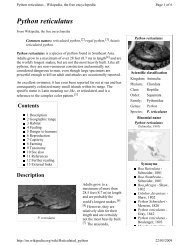Issue Thirteen 30 June 2012 - Taxonomic issue - all - Smuggled.com
Issue Thirteen 30 June 2012 - Taxonomic issue - all - Smuggled.com
Issue Thirteen 30 June 2012 - Taxonomic issue - all - Smuggled.com
Create successful ePaper yourself
Turn your PDF publications into a flip-book with our unique Google optimized e-Paper software.
Hoser <strong>2012</strong> - Australasian Journal of Herpetology 13:35-46.<br />
Australasian Journal of Herpetology 35<br />
Australasian Journal of Herpetology 13:35-46.<br />
Published <strong>30</strong> <strong>June</strong> <strong>2012</strong>.<br />
INTRODUCTION (TROPIDONOPHIS)<br />
The genus Tropidonophis Jan, 1863 was for many years<br />
synonymised with Amphiesma Duméril, Bibron and Duméril,<br />
1854. However as a result of monographs by Malnate in 1960<br />
and 1962 and another with Underwood in 1988 form<strong>all</strong>y defining<br />
both genera, most publishing herpetologists have adopted their<br />
classification without question.<br />
Available online at www.herp.net<br />
Copyright- Kotabi Publishing - All rights reserved<br />
ISSN 1836-5698 (Print)<br />
ISSN 1836-5779 (Online)<br />
A review of Natricine genera Tropidonophis Jan,<br />
1863 and Amphiesma Duméril, Bibron and<br />
Duméril, 1854 (Serpentes:Colubroidae:Natricinae).<br />
Raymond T. Hoser<br />
488 Park Road, Park Orchards, Victoria, 3114, Australia.<br />
Phone: +61 3 9812 3322 Fax: 9812 3355 E-mail: viper007@live.<strong>com</strong>.au<br />
Received 13 April <strong>2012</strong>, Accepted 20 April <strong>2012</strong>, Published <strong>30</strong> <strong>June</strong> <strong>2012</strong>.<br />
ABSTRACT<br />
The taxonomy of the Natricine genera Tropidonophis Jan, 1863 and Amphiesma Duméril,<br />
Bibron and Duméril, 1854 is reassessed on the basis of <strong>all</strong> available information.<br />
As a result the genus Tropidonophis as known is divided into two and there are a number<br />
of taxonomic acts made according to the Zoological Code.<br />
The two Philippine species are placed within a newly named genus Oxynatrix gen. nov.. It<br />
is in turn divided into subgenera to ac<strong>com</strong>modate each taxon.<br />
The remainder of Tropidonophis is divided into four subgenera, including the nominate one<br />
retaining most species, Stypohynchus Peters, 1863 for Tropidonophis truncatus (Peters,<br />
1863) with four similar species and two monotypic subgenera for the species<br />
Tropidonophis doriae (Boulenger, 1897) and Tropidonophis elongatus (Jan, 1865).<br />
Tropidonophis elongatus (Jan, 1865), is divided into three species, and one of the newly<br />
named species is in turn divided into two subspecies.<br />
The three New Guinea species Tropidonophis multiscutellatus (Brongersma, 1948),<br />
Tropidonophis novaeguineae (Lidth De Jude, 1911) and Tropidonophis picturatus<br />
(Schlegel, 1837) are each divided into two subspecies.<br />
Amphiesma is reviewed and found to be paraphyletic. Available names are found for some<br />
species groups, but five groups lacking an available name are form<strong>all</strong>y assigned to newly<br />
named genera and a single species to a newly named subgenus. These are Greernatrix<br />
gen. nov., Wellsnatrix gen. nov., Wellingtonnatrix gen. nov., Elliottnatrix gen. nov.,<br />
Asianatrix gen. nov. and Sundanatrix subgen. nov. respectively.<br />
Keywords: <strong>Taxonomic</strong> revision; new genera; new subgenera; new species; new<br />
subspecies; Tropidonophis; Amphiesma; Oxynatrix; Kirnerea; Desburkeus; Desburkei;<br />
Alanbrygelus; alanbrygeli; smythi; sammywatsonae; cottoni; trioanoi; pillotti; Greernatrix;<br />
Wellsnatrix; Wellingtonnatrix; Elliottnatrix; Asianatrix; Sundanatrix.<br />
Due in large part to the <strong>com</strong>prehensive detail in which the<br />
authors investigated these snakes and then published their<br />
results, the morphologic<strong>all</strong>y conservative water snakes from the<br />
Australasian region, genus Tropidonophis have since attracted<br />
little taxonomic interest.<br />
While there had been several attempts to erect new genera for<br />
snakes within both genera in the 1800’s, (gener<strong>all</strong>y rejected), no



